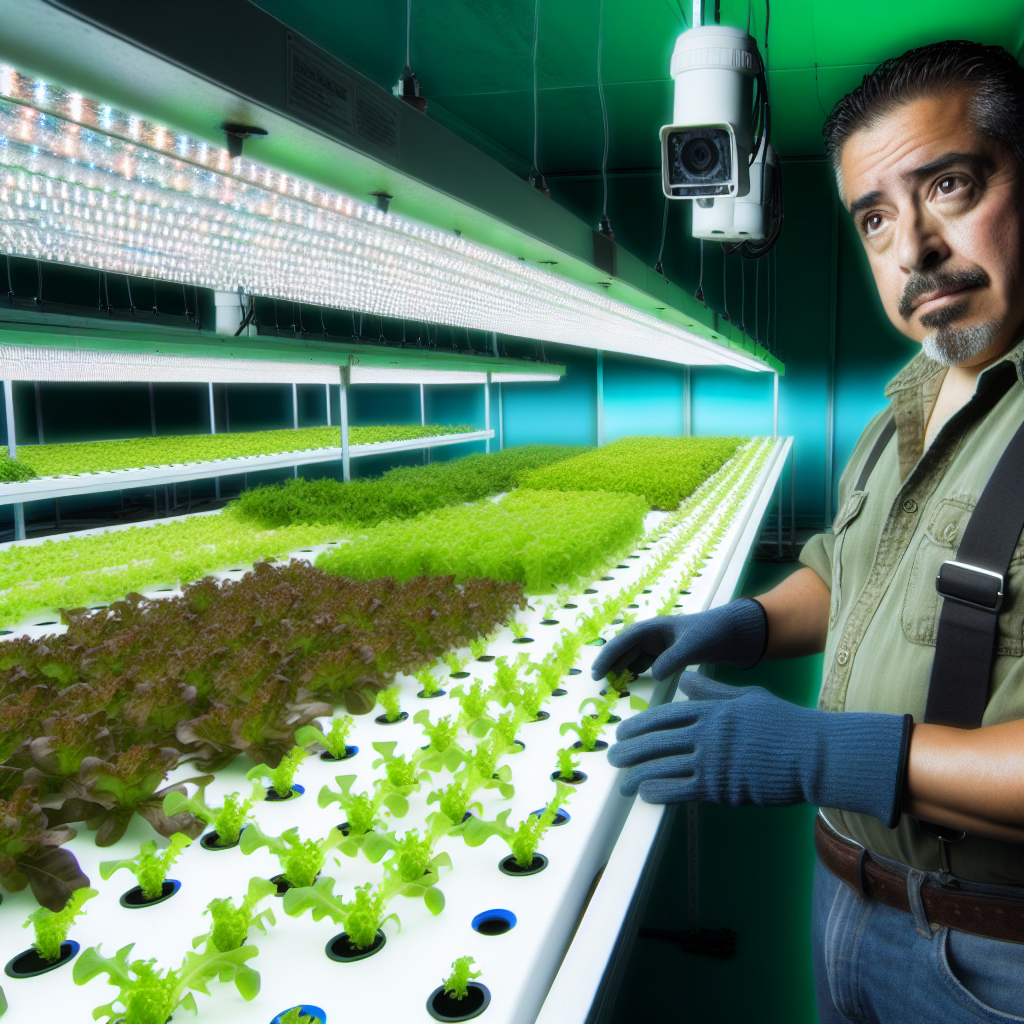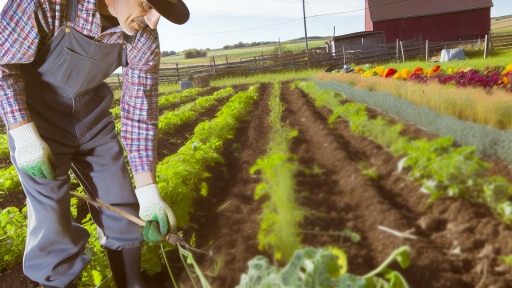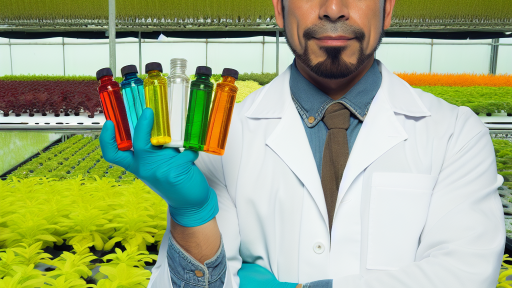Introduction to Hydroponics and Its Benefits
Hydroponics involves growing plants without soil.
Instead, it uses nutrient-rich water solutions to nourish plants.
This method offers several advantages over traditional farming.
Efficient Use of Space
Hydroponics maximizes space utilization significantly.
Vertical farming techniques allow growth in compact areas.
As a result, urban agriculture becomes more feasible.
Water Conservation
This system reduces water usage compared to conventional farming.
Hydroponics recycles water efficiently in closed systems.
Consequently, it minimizes waste and promotes sustainability.
Increased Growth Rates
Plants grown hydroponically often experience faster growth.
By delivering nutrients directly to the roots, plants thrive.
Furthermore, this method reduces competition from weeds.
Reduced Need for Pesticides
Hydroponics typically requires fewer pesticides than soil-based agriculture.
The controlled environment limits pest infestations.
As a result, crops grow healthier and are safer for consumption.
Transform Your Agribusiness
Unlock your farm's potential with expert advice tailored to your needs. Get actionable steps that drive real results.
Get StartedYear-Round Production
Growers can produce crops year-round using hydroponic systems.
Seasonal limitations no longer restrict agricultural production.
This constant availability enhances food security for communities.
Choosing the Right Hydroponic System for Yield Optimization
Understanding Hydroponics
Hydroponics involves growing plants without soil.
This technique relies on nutrient-rich water solutions.
By eliminating soil, plants can access nutrients more efficiently.
This method promotes faster growth and higher yields.
Types of Hydroponic Systems
There are several hydroponic systems to consider.
Each system has unique benefits for yield optimization.
- Deep Water Culture (DWC)
- Nutrient Film Technique (NFT)
- Ebb and Flow (Flood and Drain)
- Wick Systems
- Aeroponics
Evaluating System Efficiency
Efficiency is crucial for maximizing yields.
Consider factors such as water usage and nutrient delivery.
Measure how quickly plants grow under each system.
Environmental Factors
Light, temperature, and humidity play essential roles in hydroponics.
Ensure your chosen system supports optimal environmental conditions.
Incorporating grow lights can enhance plant growth indoors.
Customization for Yield Enhancement
Customize your hydroponic system to fit your crop needs.
Specific plants may thrive better in certain systems.
For example, leafy greens often prefer NFT setups.
Assessing Cost vs. Benefits
Evaluate the initial investment against long-term yield potential.
Some systems may have higher upfront costs but offer better returns.
Compare the costs of nutrients and electricity as well.
Seeking Expert Advice
Consult with hydroponic specialists to enhance your system’s performance.
Experts provide valuable insights tailored to your unique situation.
Networking with other growers can also yield beneficial tips.
Showcase Your Farming Business
Publish your professional farming services profile on our blog for a one-time fee of $200 and reach a dedicated audience of farmers and agribusiness owners.
Publish Your ProfileNutrient Management: Balancing Macro and Micronutrients
Understanding Nutrient Needs
Plants require different nutrients for optimal growth.
These nutrients can be divided into macronutrients and micronutrients.
Macronutrients include nitrogen, phosphorus, and potassium.
Micronutrients include iron, manganese, and zinc.
Each plays a crucial role in plant health and yield.
Macronutrient Importance
Nitrogen aids in leaf development and green color.
Phosphorus promotes root and flower development.
Potassium enhances overall plant strength and disease resistance.
Balancing these nutrients maximizes growth potential.
Micronutrient Significance
Micronutrients support various cellular functions.
Iron, for example, is vital for chlorophyll production.
Manganese helps in photosynthesis and enzyme production.
Deficiencies in micronutrients can lead to poor growth.
Measuring Nutrient Levels
Regular testing of nutrient levels is essential.
Soil and water tests provide valuable insights.
Use these tests to adjust nutrient solutions effectively.
Creating Balanced Nutrient Solutions
Mixing the right ratios of nutrients is crucial.
Refer to guidelines recommended for specific crops.
Monitor your solution regularly to ensure balance.
Adjusting pH levels is also necessary for nutrient uptake.
Application Methods
Apply nutrient solutions through various methods.
Top feeding, deep water culture, and nutrient film techniques are common.
Choose a method that suits your hydroponic setup.
Monitoring System Performance
Stay vigilant about how plants respond to nutrient adjustments.
Look for signs of nutrient deficiencies or toxicities.
Healthy plants demonstrate vibrant colors and robust growth.
Seeking Expert Advice
Consult agronomists or hydroponic specialists for guidance.
Join local farming groups to share experiences.
Continuous learning helps in perfecting nutrient management.
Delve into the Subject: Pest Management in Hydroponic Farming
Light Requirements: Types of Lighting and Their Impact on Growth
Understanding Light Spectrum
Plants rely on light for photosynthesis.
The light spectrum impacts plant growth significantly.
Different wavelengths affect various growth stages.
Blue light promotes vegetative growth.
Red light, on the other hand, encourages flowering and fruiting.
Types of Grow Lights
Several types of grow lights are available.
LED lights are popular for their efficiency.
They emit specific wavelengths tailored for plant growth.
Fluorescent lights are also commonly used.
They provide a broad spectrum and are energy-efficient.
Showcase Your Farming Business
Publish your professional farming services profile on our blog for a one-time fee of $200 and reach a dedicated audience of farmers and agribusiness owners.
Publish Your ProfileHigh-intensity discharge lights deliver a lot of light.
However, they consume more energy and generate heat.
Choosing the Right Light
Selecting the appropriate light is crucial for success.
Consider the type of plants you are growing.
Young seedlings benefit from different light than mature plants.
Evaluate your space’s height and width for optimal placement.
Adjust lighting duration according to plant needs.
Maximizing Growth with Light Management
Proper light management enhances yield significantly.
Monitor light distance to avoid burning plants.
Regularly adjust the lighting periods depending on growth stages.
Consider using a timer for consistency.
This approach will optimize your hydroponic system’s performance.
The Economic Impact of Lighting Choices
Investing in quality lighting improves overall yield.
LEDs, despite a higher initial cost, save energy over time.
Evaluate the long-term savings against upfront costs.
Choose lights based on efficiency and expected growth outcomes.
Explore Further: How to Start an Heirloom Vegetable Garden
Water Quality and pH Control for Maximum Plant Health
Importance of Water Quality
High-quality water is essential for hydroponic systems.
Clean water helps minimize disease risk in plants.
Water quality directly impacts nutrient availability.
Regular testing is crucial to maintain water standards.
Key Parameters of Water Quality
Several factors determine water quality in hydroponics.
Conductivity indicates the concentration of nutrients.
Clear water should have low turbidity levels.
Chlorine and chloramines can harm plants, so avoid them.
Understanding pH Levels
pH levels play a vital role in nutrient absorption.
Most plants thrive in a pH range of 5.5 to 6.5.
Regular pH monitoring ensures optimal growth conditions.
pH imbalances can lead to nutrient lockout.
Methods for pH Control
Adjusting the pH can improve plant health significantly.
Using pH Up or pH Down solutions is common.
Adding organic acids can also help in pH management.
Frequent testing allows for timely adjustments.
Monitoring Techniques
Utilize pH meters for accurate readings.
Keep calibration solutions handy for maintenance.
Test water both before and after nutrient addition.
Document changes consistently for better management.
Impact of Poor Water and pH Management
Neglecting water quality can lead to plant stress.
Pests and diseases thrive in poor conditions.
Chlorinated water can stunt plant growth significantly.
Showcase Your Farming Business
Publish your professional farming services profile on our blog for a one-time fee of $200 and reach a dedicated audience of farmers and agribusiness owners.
Publish Your ProfileExtreme pH levels can cause plants to wither or die.
Maintaining Optimal Hydroponic Conditions
Regular monitoring is a key to successful hydroponics.
Investing effort in water quality pays off with better yields.
Your plants will thrive when you promote optimal conditions.
See Related Content: Sustainable Practices in Aquaponics Farming
Temperature and Humidity Control
Establishing Optimal Temperature
Maintaining the right temperature is crucial for hydroponic growth.
Different plants thrive at varying temperatures.
For example, lettuce prefers cooler conditions, while tomatoes enjoy warmth.
Generally, keep temperatures between 65°F to 75°F for most hydroponic plants.
Additionally, monitoring daily temperature fluctuations aids growth consistency.
Humidity Management Techniques
Humidity levels significantly affect plant health in hydroponic systems.
Optimal humidity often ranges from 40% to 70% depending on the plant type.
High humidity can lead to mold and other diseases.
Conversely, low humidity may stress plants and hinder growth.
Using a hygrometer assists in tracking humidity levels effectively.
Benefits of Environmental Control
Controlling temperature and humidity maximizes yield potential.
Healthy plants produce higher quantities of fruits and vegetables.
Moreover, consistent environments reduce plant stress.
As a result, crops reach maturity faster and with improved quality.
Strategies for Effective Control
- Employ thermostats and humidistats to automate adjustments.
- Consider ventilation systems to enhance air circulation.
- Utilize evaporative coolers or dehumidifiers as needed.
These strategies ensure a stable environment for flourishing hydroponic plants.
Regular Monitoring and Adjustments
Consistently monitor conditions to make necessary adjustments.
Regular checks prevent sudden changes that could harm plants.
Consider integrating technology, such as smart sensors, for real-time updates.
Keeping logs of environmental changes allows for better forecasting.
Learn More: The Power of Container Farming: A Guide to High-Yield Gardens

Pest and Disease Management Strategies in Hydroponic Systems
Understanding Common Pests
Pests can severely impact hydroponic productivity.
Common pests in hydroponic systems include aphids, whiteflies, and spider mites.
Recognizing these pests early can help prevent larger infestations.
Inspect plants regularly to catch issues before they escalate.
Implementing Integrated Pest Management
Integrated Pest Management (IPM) offers a holistic approach to pest control.
This strategy combines biological, cultural, and chemical controls.
Biological controls include introducing beneficial insects like ladybugs.
Cultural practices involve maintaining clean and sanitized environments.
Using pesticides should be a last resort within an IPM plan.
Monitoring and Preventing Diseases
Disease prevention is crucial in hydroponic systems.
Common diseases include powdery mildew and root rot.
Monitoring environmental conditions helps prevent the onset of these diseases.
Maintain proper humidity, temperature, and nutrient levels in your system.
Maintaining Healthy Nutrient Solutions
Nutrient imbalances can lead to plant stress and susceptibility to diseases.
Regularly test and adjust your nutrient solutions for optimal plant health.
Showcase Your Farming Business
Publish your professional farming services profile on our blog for a one-time fee of $200 and reach a dedicated audience of farmers and agribusiness owners.
Publish Your ProfileUsing high-quality, balanced nutrient solutions supports vigorous growth.
Utilizing Technology for Pest and Disease Detection
Technology plays a role in modern pest and disease management.
Cameras and sensors can monitor plant conditions in real-time.
Data analytics can predict pest outbreaks before they happen.
Investing in these tools enhances your overall management strategy.
Educating Yourself and Your Team
Knowledge empowers effective pest and disease management.
Stay informed about the latest trends and techniques in hydroponics.
Participating in workshops and training sessions can be beneficial.
Share knowledge with your team to foster a proactive environment.
Creating a Responsive Action Plan
Developing an action plan is essential for addressing unforeseen issues.
Your plan should include clear procedures for pest or disease identification.
Additionally, outline steps for treatment and prevention.
Regularly update the plan based on new insights and experiences.
Crop Selection: Identifying High-Yielding Varieties for Hydroponics
Understanding Hydroponic Crop Requirements
Choosing the right crop is crucial for successful hydroponic farming.
Each plant has unique requirements for light, temperature, and nutrients.
Understanding these needs helps optimize growth and yields.
Factors Influencing Crop Selection
Several factors influence your choice of crops in hydroponic systems.
Growth rates and yield potentials are key considerations.
Additionally, resistance to pests and diseases plays a significant role.
Varieties that adapt well to hydroponic conditions are preferred.
Top High-Yielding Varieties for Hydroponics
Some crops consistently perform well in hydroponic systems.
- Lettuce is a popular choice for its fast growth and high yield.
- Tomatoes thrive in hydroponic setups, providing abundant harvests.
- Peppers are also suitable, offering a variety of colors and flavors.
- Basil and other herbs yield well and require minimal space.
Evaluating Local Conditions
Consider local conditions when selecting crops for your hydroponic system.
Climate can affect growth rates and plant health significantly.
Moreover, access to water and light impacts your crop choices.
Evaluate how these factors interplay with your selected varieties.
Consulting Experts and Resources
Leverage expertise from local agricultural extensions and hydroponic specialists.
Researching recent studies can also provide valuable insights.
Networking with other hydroponic growers can lead to successful crop selections.
Harvesting Techniques: Timing and Methods to Maximize Returns
Understanding the Right Timing
Timing affects the overall yield in hydroponic systems.
Harvest crops at their peak maturity for the best flavor and nutrition.
Monitor growth stages closely to identify optimal harvesting times.
Utilize tools, such as a refractometer, to measure sugar levels in fruits.
Apply a consistent schedule for monitoring plant development.
Methods for Efficient Harvesting
Effective harvesting methods enhance yield and reduce waste.
Use sharp tools for trimming plants to prevent damage.
Cut stems cleanly to encourage regrowth in some crops.
Employ the right harvesting technique based on plant type.
- For leafy greens, use a clean pull or cut method.
- For fruiting plants, delicately twist or cut to avoid bruising.
- For root vegetables, leverage digging tools carefully.
Post-Harvest Handling Practices
Post-harvest practices significantly impact marketability.
Immediately cool harvested produce to preserve freshness.
Implement proper washing techniques to remove contaminants.
Showcase Your Farming Business
Publish your professional farming services profile on our blog for a one-time fee of $200 and reach a dedicated audience of farmers and agribusiness owners.
Publish Your ProfileStore products in suitable conditions to prolong shelf life.
Maintain optimal humidity and temperature during storage.
Maximizing Market Returns
Understanding market demand can boost profitability.
Research local market preferences to grow desirable crops.
Offer diverse varieties to attract a broader customer base.
Participate in community-supported agriculture (CSA) programs.
Engage with local farmers’ markets to enhance visibility.
Continuous Improvement and Monitoring
Establish a cycle of continuous improvement in your practices.
Regularly assess the outcomes of your harvesting strategies.
Gather feedback from customers to refine your offerings.
Experiment with different varieties and techniques for enhancement.
Document results to inform future planting and harvest decisions.
Case Studies: Successful Hydroponic Operations and Yield Maximization
Profile of GreenLeaf Hydroponics
GreenLeaf Hydroponics serves as a stellar example of yield maximization.
This company specializes in leafy greens and herbs.
Their advanced techniques have led to impressive outcomes.
For instance, they utilize vertical farming systems to save space.
In addition, they implement efficient nutrient delivery systems.
This approach minimizes waste and maximizes growth.
Consequently, their yields surpass traditional farming methods.
Maximizing Light Utilization
Another key factor in their success involves optimal light usage.
GreenLeaf employs LED lighting tailored to plant needs.
This technology enhances photosynthesis and growth rates.
Moreover, they follow a strict light schedule to ensure consistency.
As a result, plants achieve quicker harvest times.
Innovation at Urban Roots
Urban Roots is another successful case in hydroponics.
This organization focuses on urban agriculture in limited spaces.
They use aquaponic systems to integrate fish farming with plant cultivation.
This creates a sustainable environment and efficient resource use.
Furthermore, Urban Roots emphasizes community engagement.
By educating locals, they inspire more individuals to adopt hydroponics.
Standard Operating Procedures
The establishment of standard operating procedures (SOPs) is crucial.
Urban Roots meticulously documents every aspect of their operation.
This documentation helps maintain consistency and quality.
As a result, they can combine research with practical methods effectively.
Transformation at FreshFields Hydroponics
FreshFields Hydroponics also provides a notable example.
They focus on organic produce cultivated in hydroponic systems.
This commitment to organic farming attracts a dedicated customer base.
Additionally, they monitor environmental conditions diligently.
This ensures optimal growth and healthy crops.
Data-Driven Decision Making
FreshFields employs data analytics to guide their operations.
Showcase Your Farming Business
Publish your professional farming services profile on our blog for a one-time fee of $200 and reach a dedicated audience of farmers and agribusiness owners.
Publish Your ProfileThis strategy allows them to predict yield outcomes accurately.
They utilize sensors to monitor pH, temperature, and nutrient levels.
Such measures greatly enhance their farming efficiency.
Strategies for Yield Maximization
These case studies illustrate diverse strategies for yield maximization.
Each operation successfully integrates innovative techniques.
Consequently, they achieve impressive growth rates and sustainability.




